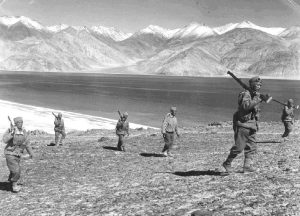October 20, 2022, marks the 60th anniversary of a key event in modern Indian history, the 1962 border war with China. The brief war, in which Beijing defeated Delhi, represents an often-underappreciated watershed in Delhi’s foreign and security policies. 1962 marked the end of the Nehruvian era in Indian foreign policy and led to the emergence of a decisively more muscular and more realist India on the international stage. Even more importantly, the 1962 war inaugurated long-term changes in Delhi’s approach to international relations, which continue to shape Indian foreign policy to this day.
The war’s immediate impact on India was to put an end to the Nehruvian era in Indian foreign policy, a period dominated by the ideas of Prime Minister Jawaharlal Nehru. While a complex and constantly evolving mixture of realist and idealist elements, India’s Nehruvian foreign policy had five principal elements: 1) nonalignment with the two Cold War superpowers; 2) the tendency toward moralpolitik inherited from India’s independence movement; 3) the pursuit of Indian leadership among newly independent countries in the so-called Third World; 4) the preference for cooperation over competition; and 5) the de-emphasis of security and military power, for ideational and pragmatic reasons.
Nehruvian foreign policy pushed India to seek a special cooperative relationship with China, another major Asian power with which it was morally right and pragmatic to cooperate. In this framework, China was seen as a post-colonial partner in leading the Third World and a challenger to the bipolar international order of the Cold War that Delhi refused to accept. Thus, partnership with China, embodied in the slogan “Hindi-Chini Bhai Bhai,” became a cornerstone of Nehruvianism.
The 1962 Sino-Indian War delivered a massive blow to this type of foreign policy. It proved that Nehruvian policy cannot safeguard India’s security and that defense and military power should have been priorities for Delhi. It demonstrated that in the face of attack, a nonaligned and poorly armed India can rely neither on its own limited military power nor on allies (although non-allies the United States and Britain eventually supported India). Predictably, Delhi’s moralpolitik and Third Worldism proved useless in the crisis. Most crucially, the war showed that the partnership with China was a mistake.
The whole brutal experience demonstrated that India needed a more muscular and more explicitly realist foreign policy, which began to take shape during Nehru’s last two years in power but fully emerged after several turbulent years following Nehru’s demise in 1964.
Beyond ending the Nehruvian period, the war prompted three major long-term transformations in India’s foreign and security policy that shape it to this day. First, the war led Delhi to focus on its military and thus inaugurated the rise of India as a major military power. After the war India’s defense spending rose massively, increasing from 2.1 percent of GDP in 1961 to 4 percent in 1963, and stayed consistently above 3 percent of GDP for the rest of the Cold War. It has never returned to pre-1962 levels. 1962 also prompted major military reforms and a massive push to reshape and expand India’s defense industry. The war played a role in India’s decision to conduct nuclear tests in 1974 and acquire nuclear weapons in 1998. Hence, ironically, Delhi’s defeat in 1962 spearheaded India’s military rise.
Second, the 1962 war produced a long-term shift toward greater realpolitik in Indian foreign policy. The first signs of the shift occurred during the war itself, as the Chinese onslaught in October and November 1962 forced Nehru to turn to the U.S. and the U.K. for arms and supplies and even ask the U.S. Air Force to intervene. However, the shift toward a more realpolitik approach took full effect under Indira Gandhi, who had a much more power-oriented foreign policy. Under her rule, India would partner with the Soviet Union in 1971, break up its archrival Pakistan, and seek to establish a much more decisive Indian primacy in South Asia under the so-called “Indira doctrine.” Since then, India’s foreign policy has usually leaned in a realpolitik direction, to one degree or another.
Third, the 1962 war led Delhi to permanently redefine China as a potential security threat and thus change its understanding of its own security environment. Even after Beijing and Delhi relaunched their relationship in 1988 and signed major defense agreements in 1993 and 1996, India continued to identify China as a major, potential security threat. India’s consistent security concerns about China were best expressed by then-Prime Minister Atal Bihari Vajpayee who, in a secret letter to U.S. President Bill Clinton in 1998, justified India’s acquisition of nuclear arms by pointing to “an overt nuclear weapon state on our borders, a state which committed armed aggression against India in 1962.”
The definition of Beijing as a threat, immediate or potential, transformed India’s understanding of its own security environment as it faced Delhi with a possibility of two-front conflict with the China-Pakistan “all weather” alliance. While the likelihood of such two-front conflict has varied over time, it has persisted and defines Indian security policy to this day.
In short, the 1962 war represented an important watershed in India’s foreign and security policy, with consequences that are still felt today. Rarely has a war so brief and so militarily inconsequential produced so much change.

































